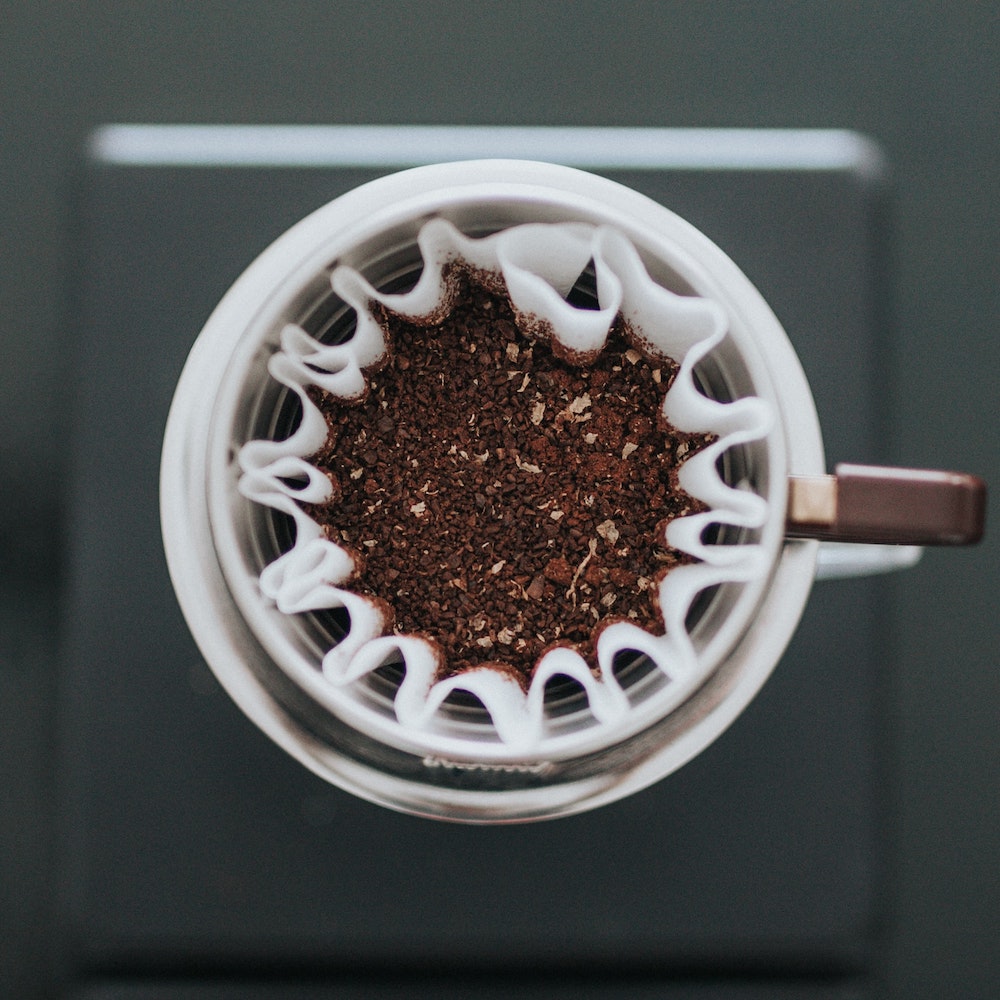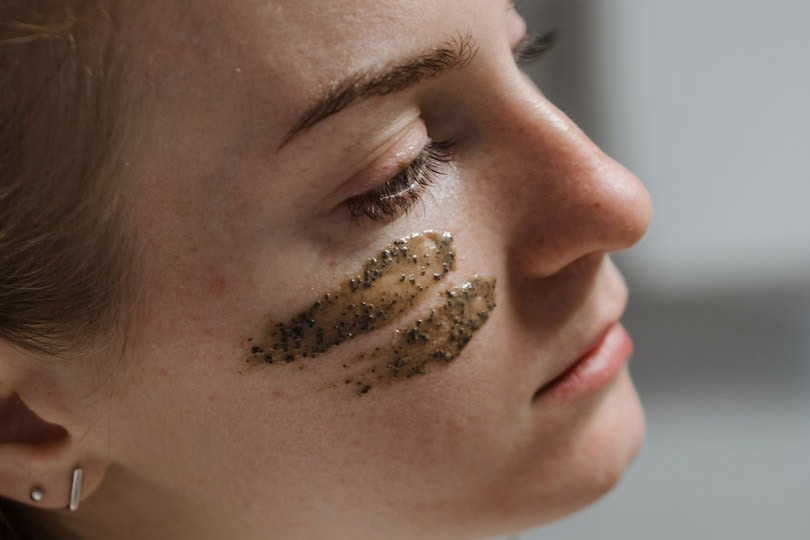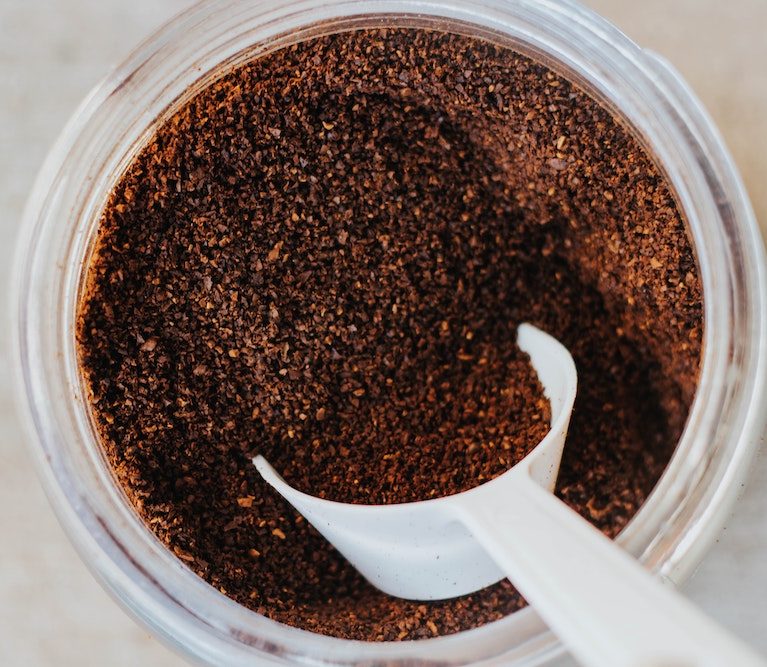
You might not realize it, but those coffee grounds you throw away every morning could have a second life. Whether you’re buying premium single-origin beans or full-bodied blends, you might as well get the most out of your coffee budget and help the environment, too. From their texture to their nutrient load, your coffee grounds have a lot to offer.
To get you started, here is a list of suggestions for your used coffee grounds. We hope it helps you find a good use for your grounds. Maybe you’ll even think of another use for coffee grounds!

The 17 Genius Uses for Coffee Grounds
1. Compost
Warm, wet, and filled with nitrogen, used coffee grounds have a very natural use in fertilizing plants. Some people like to mix the grounds directly into the soil, but that application tends to break down slowly. The best use of coffee grounds to grow plants is as part of a well-rounded compost, where the heat of decay helps break them down much more quickly.

2. Refrigerator deodorizer
Coffee grounds absorb odors, which makes them as good as baking soda at absorbing the nasty odors of a refrigerator. The same nitrogen that makes them a great soil addition also reacts with sulfur in the air, pulling it out and trapping it in the grounds. Plus, this is not just a deodorizer that works in refrigerators. It works just about anywhere you have nasty smells.
3. Sidewalk ice melt
Coffee grounds can be tossed on a newly shoveled sidewalk in the depths of winter. The chemical makeup of the coffee will prevent it from freezing until temperatures are a little lower and will help melt some of the ice. The gritty texture of coffee grounds also allows them to add some traction value on ice.

4. Better blue blooms
If you’ve got some flowering plants in your garden that thrive in a lower pH soil, sprinkle some acidic coffee grounds into their soil. As the grounds slowly break down, they will bring down the pH value of the soil. That will allow flowers like the blue-blooming hydrangea to flourish.
5. Slug barrier
Slugs do not like the acidic quality of coffee grounds, so they will avoid crossing coffee grounds when possible. If you’ve got a garden where slugs are a problem, coffee grounds can make an inexpensive and effective repellent. The slugs will stay out. One thing you’ll want to keep an eye on is that the degrading coffee grounds will drop the pH value a little, which can be a problem if you have plants that favor alkaline soils.
6. Exfoliant
Coffee grounds have a texture a lot like sand, so you can use them as a natural scrubbing agent. You can either use the grounds directly on your skin to help scrub away dead skin cells and clean out clogged pores, or form them into a solidified exfoliating bar. Either way, coffee grounds are good for your skin.

7. Scrub your pans clean
The same scour power that helps remove dead cells from your skin also helps clean caked-on food particles off your cooking pans. Just like pioneers used sand to scrub off food particles because they didn’t have steel wool, you can use coffee grounds to clean out your cooking pans.
8. Hand cleaner
Used on your face, coffee grounds can remove dead skin cells and soften your skin. But on your hands, they can do something a little different. Pumice soaps are used to scour away tough dirt and grime from working on cars or machines. Coffee grounds offer an affordable, readily available alternative that will leave your hands smelling a little like morning.
9. Meat rub
Coffee is an under-appreciated element of cooking. It’s the central ingredient in red-eye gravy, and can be found in everything from barbecue sauces to chocolate desserts. But coffee grounds also have a natural smoky flavor when used as a meat rub for meats like brisket, ribs, or even a tender cut of steak. This is a really great way to extend the value of very expensive coffee grounds because you can tailor the meat to the actual flavor of the coffee. One great added benefit is that the acid will break down the meat and tenderize it.

RELATED READ: What Is Red-Eye Gravy? (With Recipe)
10. Beer brewing
Fans of craft brewing probably already recognize the java brew from their favorite brewpub. Many breweries use coffee to make beer, typically producing stouts and porters that can be great with lunch on a cold afternoon. If you have some reading to do in the evening, it’s a nicely caffeinated way to not fall asleep.
11. That old-timey look
British soldiers during the era of Queen Victoria stained their helmets with tea to give them a brownish look. Take that to heart when thinking about what to do with your used grounds. Some people pay a lot of money for a ripped or used look, and using grounds to stain clothing is a good option when you’re done with your coffee.
12. Arts and crafts
If you want to give craft paper a more antique look, try staining it with coffee grounds. In fact, coffee grounds will help you stain a lot of arts and crafts projects in a way that makes them look naturally aged. This also applies to Easter eggs you might want to dye to look like you’re living during the Roaring 20s.

13. Shiny hair
You wouldn’t want to use coffee grounds on lighter hair like blonde or red, but if you’ve got dark hair like chestnut or black, coffee grounds will not only help strip dirt from your hair, but the acids will also help to soften it. Use this sparingly so you don’t extend the cleaning properties into stripping out vital nutrients.
14. Furniture stain
Coffee grounds can add a little lustrous darkening to anything you want stained. That includes wood, for which coffee grounds can add some affordable but deep dark staining. You can either mix it in with water for a thin paint, or you can rub it in and let it sit for an hour or so before cleaning it off for a more natural look.
15. Bug repellent
Slugs aren’t the only garden pest repelled by coffee grounds. Slugs don’t like the acidic nature of the grounds, but other things don’t like the smell. You can either mix your grounds into the soil to repel certain underground pests or spread it over the dirt to keep out insects and even cats. Just be aware that coffee grounds will turn everything a little more acidic as they break down.
16. Fireplace dust
If you’re getting ready to clean up the soot in a fireplace, coffee grounds spread across the cleaning surface will help keep the dust down by adding some moisture to the very dry soot. That’ll keep it from drifting up into the air. Just scoop it up and shovel it away.

17. Food for worms
While slugs and other garden pests hate coffee grounds, worms love to munch on their nutrient-rich grit. Mix them in well, and you not only add a lot of nitrogen to the soil, but the large pieces of grit that are coffee grounds mean that whatever soil you’ve got your worms in will remain well-aerated.
Note: Here are some other interesting uses for used coffee grounds that we stumbled upon.
See also:
- 14 Smart Uses for Coffee Filters: Recycle & Save Money
- How to Store Coffee Beans: Here’s The Best Way to Keep them Fresh
- Can You Use Coffee Grounds Twice?
- 13 Clever Uses for Old Coffee Beans
Table of Contents















